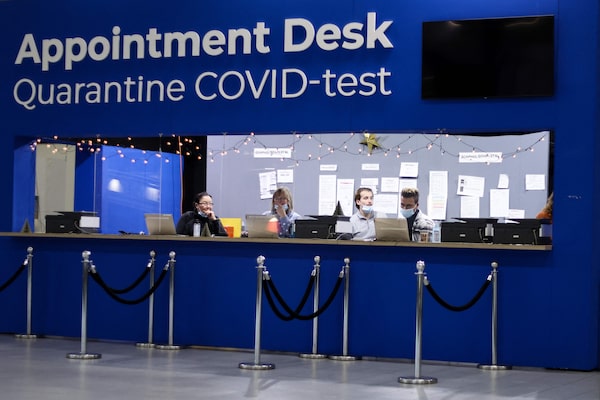
The Amsterdam Airport Schiphol's appointment desk for Covid-19 test on Nov. 29.KENZO TRIBOUILLARD/AFP/Getty Images
Economic powerhouses Japan and France reported their first cases of the omicron variant Tuesday, while new findings indicate the mutant coronavirus was already in Europe close to a week before South Africa sounded the alarm.
The Netherlands’ RIVM health institute disclosed that patient samples dating from Nov. 19 and 23 were found to contain the variant. It was last Wednesday, Nov. 24, that South African authorities reported the existence of the highly mutated virus to the World Health Organization.
That indicates omicron had a bigger head start in the Netherlands than previously believed.
Together with the cases in Japan and France, the finding illustrates the difficulty in containing the virus in an age of jet travel and economic globalization. And it left the world once again whipsawed between hopes of returning to normal and fears that the worst is yet to come.
The pandemic has shown repeatedly that the virus “travels quickly because of our globalized, interconnected world,” said Dr. Albert Ko, an infectious disease specialist at the Yale School of Public Health. Omicron demonstrates that until the vaccination drive reaches every country, “we’re going to be in this situation again and again.”
Much remains unknown about the new variant, including whether it is more contagious, as some health authorities suspect, whether it makes people more seriously ill, and whether it can thwart the vaccine.
But a WHO official said that given the growing number of omicron cases in South Africa and neighboring Botswana, parts of southern Africa could soon be witnessing a steep rise in infections.
“There is a possibility that really we’re going to be seeing a serious doubling or tripling of the cases as we move along or as the week unfolds,” said Dr. Nicksy Gumede-Moeletsi, a WHO regional virologist.
After a period of low transmission in South Africa, new cases began to increase rapidly in mid-November. The country is now seeing nearly 3,000 confirmed new infections per day.
As of Tuesday, 44 cases of omicron were reported across 11 European Union nations, said the EU’s European Center for Disease Prevention and Control, adding that the majority involved a history of travel to Africa. Outside the EU and southern Africa, omicron infections have turned up in such places as Australia, Canada, Britain and Israel.
American disease trackers said omicron could already be in the United States and probably will be detected soon.
“I am expecting it any day now,” said Scott Becker of the Association of Public Health Laboratories. “We expect it is here.”
While the variant was first identified by South African researchers, it is unclear where and when it originated — information that could help shed light on how fast it spreads.
The announcement from the Dutch on Tuesday could shape that timeline.
Previously, the Netherlands said it found the variant among passengers who came from South Africa on Friday, the same day the Dutch and other EU members began imposing flight bans and other restrictions on southern Africa. But the newly identified cases predate that.
NOS, the Netherlands’ public broadcaster, said that one of the two omicron samples came from a person who had been in southern Africa.
Belgium reported a case involving a traveler who returned to the country from Egypt on Nov. 11 but did not become sick with mild symptoms until Nov. 22.
Japan announced a ban on all foreign visitors starting Tuesday — the same day the country confirmed its first omicron case, in a Namibian diplomat who had recently arrived from his country.
France likewise recorded its first case, in the island territory of Reunion in the Indian Ocean. The patient was identified as a man who had returned to Reunion from South Africa and Mozambique on Nov. 20, before WHO learned of the variant.
Many health officials tried to calm fears, insisting that vaccines remain the best defense and that the world must redouble its efforts to get the shots to every part of the globe.
Emer Cooke, chief of the European Medicines Agency, said that the 27-nation EU is well prepared for the variant and that the vaccine could be adapted for use against omicron within three or four months if necessary.
England reacted to the emerging threat by making face coverings mandatory again on public transportation and in stores, banks and hair salons. And one month ahead of Christmas, the head of Britain’s Health Security Agency urged people not to socialize if they don’t need to.
After COVID-19 led to a one-year postponement of the Summer Games, Olympic organizers began to worry about the February Winter Games in Beijing. Chinese Foreign Ministry spokesperson Zhao Lijian said omicron would “certainly bring some challenges in terms of prevention and control.”
World markets continued to seesaw on every piece of medical news, whether worrisome or reassuring. Stocks fell on Wall Street in the morning after Moderna’s CEO expressed concern about the effectiveness of the vaccines against omicron.
Around the globe, stocks mostly slipped as investors weighed how much damage the variant might do to the economy.
Some analysts think a serious economic downturn will probably be averted because many people have been vaccinated. But they also think a return to pre-pandemic levels of economic activity, especially in tourism, has been dramatically delayed.
Editor’s note: A previously published version of this story carried an inaccurate headline that said Omicron was detected in the Netherlands before flights arrived from South Africa with the variant on board. In fact, test samples were taken before the flight in question, but the Omicron variant was detected after that. This version has been corrected.
Sign up for the Coronavirus Update newsletter to read the day’s essential coronavirus news, features and explainers written by Globe reporters and editors.